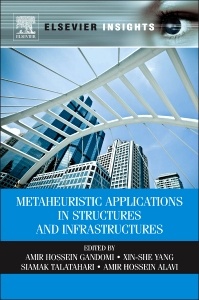Description
Metaheuristic Applications in Structures and Infrastructures
Coordinators: Yang Xin-She, Talatahari Siamak, Alavi Amir Hossein
Language: English
Subjects for Metaheuristic Applications in Structures and Infrastructures:
568 p. · 15x22.8 cm · Hardback
Description
/li>Contents
/li>Readership
/li>Biography
/li>Comment
/li>
Due to an ever-decreasing supply in raw materials and stringent constraints on conventional energy sources, demand for lightweight, efficient and low-cost structures has become crucially important in modern engineering design. This requires engineers to search for optimal and robust design options to address design problems that are commonly large in scale and highly nonlinear, making finding solutions challenging. In the past two decades, metaheuristic algorithms have shown promising power, efficiency and versatility in solving these difficult optimization problems.
This book examines the latest developments of metaheuristics and their applications in structural engineering, construction engineering and earthquake engineering, offering practical case studies as examples to demonstrate real-world applications. Topics cover a range of areas within engineering, including big bang-big crunch approach, genetic algorithms, genetic programming, harmony search, swarm intelligence and some other metaheuristic methods. Case studies include structural identification, vibration analysis and control, topology optimization, transport infrastructure design, design of reinforced concrete, performance-based design of structures and smart pavement management. With its wide range of everyday problems and solutions, Metaheursitic Applications in Structures and Infrastructures can serve as a supplementary text for design courses and computation in engineering as well as a reference for researchers and engineers in metaheuristics, optimization in civil engineering and computational intelligence.
- Mataheuristics in Modelling and Optimization
- Traditional and Modern Structural Optimization Techniques – Theory and Application
- Metaheuristics and Applications in Structural and Construction Engineering
- Particle Swarm Optimization in Civil Infrastructure Systems: State-of-the-art Review and Case Study
- Metaheuristics in Structural Design Optimization
- Multidisciplinary Design and Optimization Algorithms
- Cost Optimization of Column Layout Design of Reinforced Concrete Buildings
- Layout Design of Beam-Slab Floors by the Genetic Algorithm
- Mathematical and Metaheuristic Applications in Design Optimization of Steel Frames
- Optimum Design of Skeletal Structures via Big Bang–Big Crunch Algorithm
- Hybrid Formulations of Harmony Search and Big Bang–Big Crunch for Weight Minimization of Truss Structures
- Shape Design Optimization using Evolutionary Optimization Algorithms
- Graph-based Coding for Truss Topology Optimization
- Element Exchange Method for Topology Optimization
- Structural Control using Stochastic Methodologies
- Evolutionary Path-Dependent Damper Optimization for Variable Building Stiffness Distributions
- Application of the Genetic Algorithm in the Ground Motion Selection for the Structural Analysis
- Optmizaiton of Tuned Mass Damper with Harmony Search
- Identification of Passive Devices for Vibration Control by Evolutionary Algorithms
- Structural Optimization for Frequency Constraints
- Optimum Performance-Based Seismic Design of Frames using Meta-Heuristic Optimization Algorithms
- Expression Programming Techniques for Formulation of Structural Engineering Systems
- An Evolutionary Divide-and-Conquer Strategy for Structural Identification
- Evolutionary Algorithms for Large-Scale Optimization in Construction Management
- Network-Level Infrastructure Management based on Meta-Heuristics
- Meta-heuristic Algorithms for Large-Scale Maintenance Optimization Problems for Civil Infrastructure Systems
- Metaheuristic Applications in Bridge Infrastructure Maintenance Scheduling Considering Stochastic Aspects of Deterioration
Advanced students, researchers and professional engineers in metaheursitics, optimization and computational intelligence and computational methods in civil engineering.
Dr. Siamak Talatahari received his Ph.D degree in Structural Engineering from University of Tabriz, Iran. After graduation, he
joined the University of Tabriz where he is presently Professor of Structural Engineering. He is the author of more than 100 papers
published in international journals, 30 papers presented at international conferences and 8 international book chapters. Dr. Talatahari
has been recognized as Distinguished Scientist in the Ministry of Science and Technology and as Distinguished Professor at the
University of Tabriz. He also teaches at the Yakin Dogu University, Nicosia, Cyprus. In addition, he is a co-author with our author
Xin-She Yang of Swarm Intelligence and Bio-Inspired Computation: Structural Optimization Using Krill Herd Algorithm;
Metaheuristics in Water, Geotechnical and Transport Engineering, and Metaheuristic Applications in Structures and
Infrastructures, all published by as Insights by Elsevier.
Amir Hossein Alavi is an Assistant Professor in the Department of Civil and Environmental Engineering, and holds courtesy appointments in the Department of Bioengineering and Department of Mechanical Engineering and Materials Science, at the University of Pittsburgh, United States. His multidisciplinary scientific studies are organized around three rese
- Review of the latest development of metaheuristics in engineering.
- Detailed algorithm descriptions with focus on practical implementation.
- Uses practical case studies as examples and applications.




